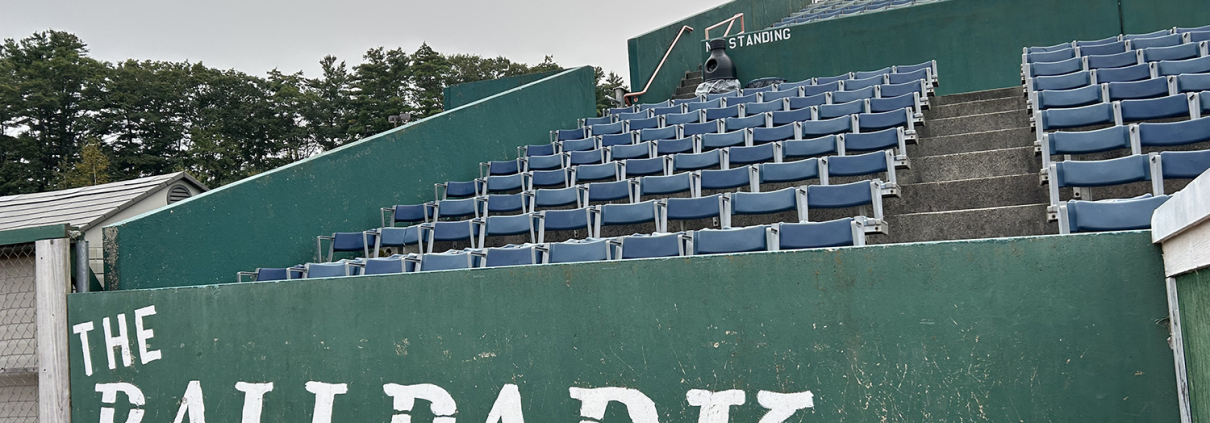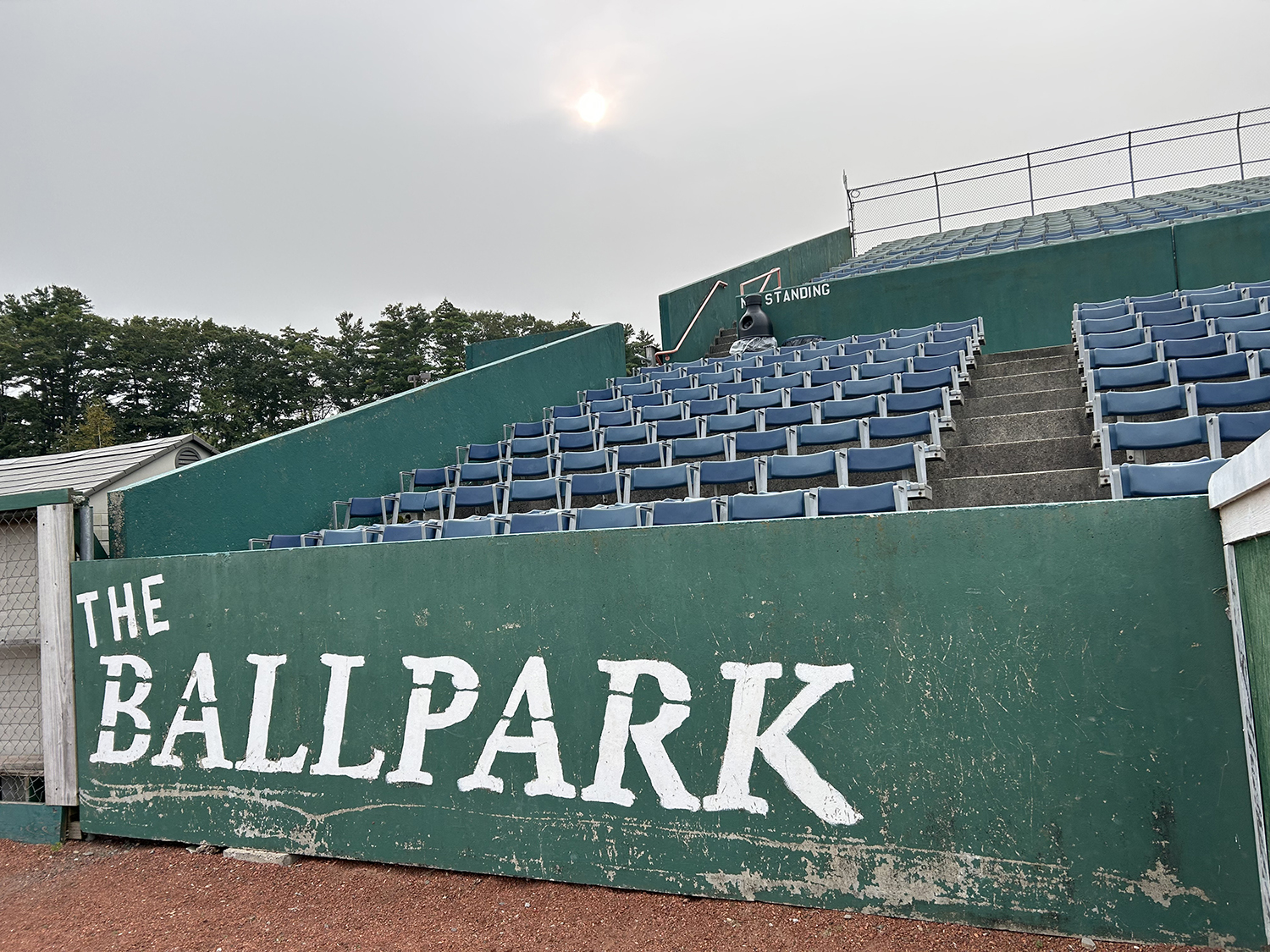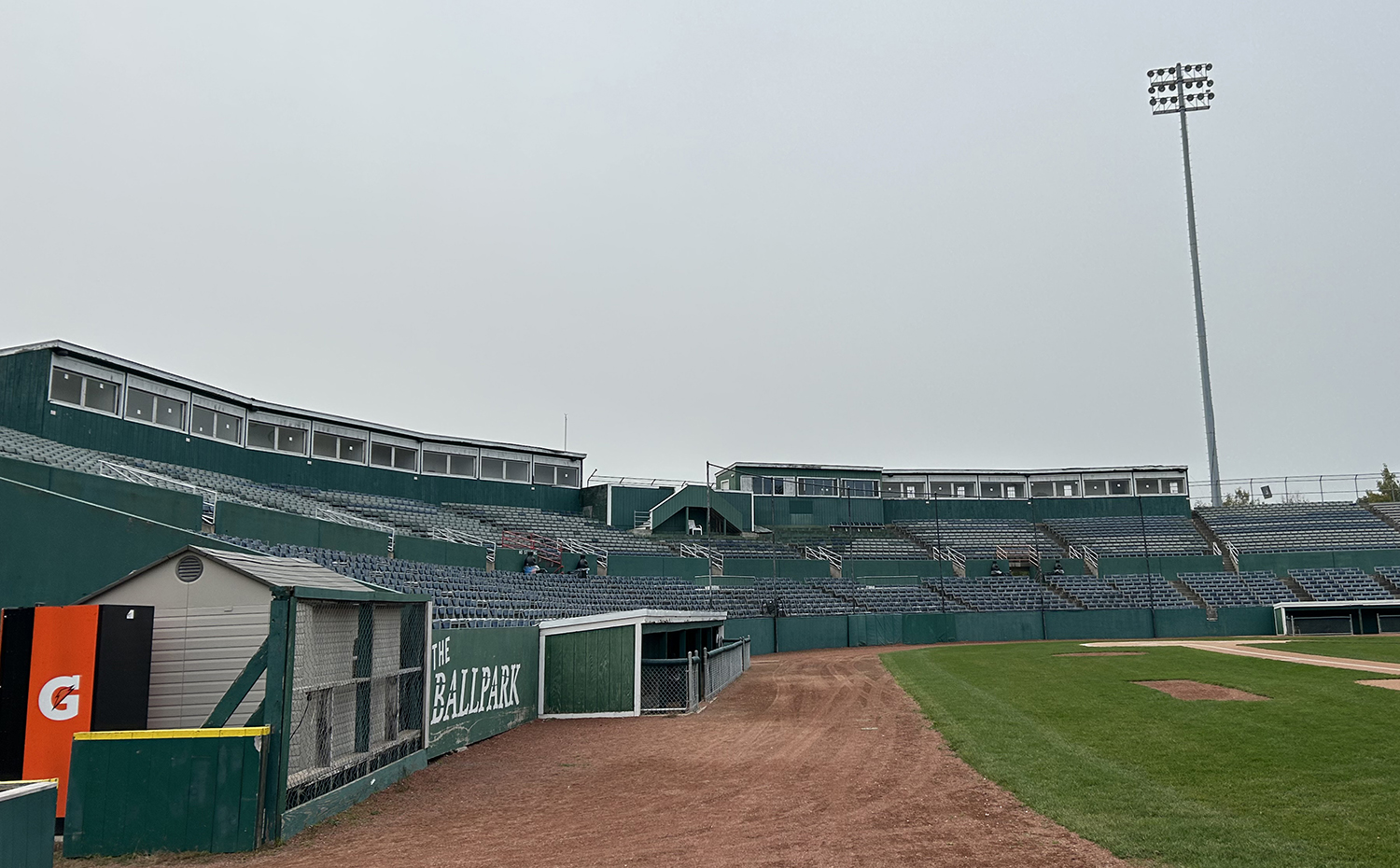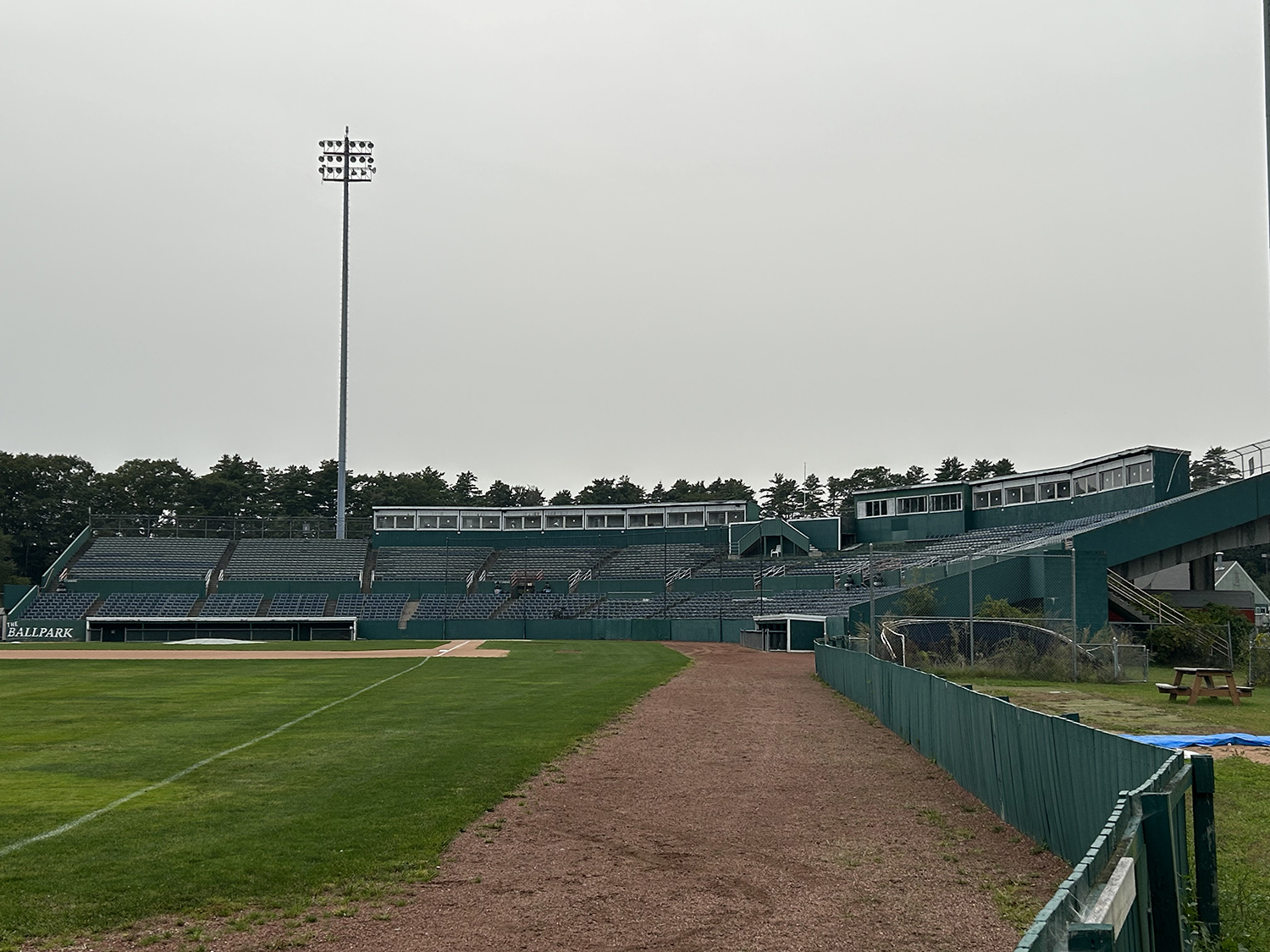The Ballpark (Old Orchard Beach, ME)
This article was written by Kurt Blumenau
The Ballpark at Old Orchard Beach, as pictured in 2023. (Courtesy of Kurt Blumenau)
Before there was The Ballpark at Arlington, The Ballpark at Jackson, The Ballpark at Harbor Yard or The Ballpark at Disney’s Wide World of Sports, there was simply The Ballpark, in Old Orchard Beach, Maine.1
The pine-bordered park with the no-frills name hosted professional baseball for only five seasons, 1984 through 1988, when the Maine Guides and Phillies of the Triple-A International League called Old Orchard Beach home. But in those few years, The Ballpark drew national attention and helped create lasting memories for players and fans. The park also led a colorful existence after pro baseball departed. It became a concert venue, but then fell into decrepitude; it was then restored and became a community asset once again.
The story of The Ballpark begins with Jordan Kobritz, a successful attorney and diehard Boston Red Sox fan from Bangor, Maine. Driven by a dream of owning a minor-league team, Kobritz left his legal practice at age 35 in 1981 and traveled across the country to learn more about the business of the sport.2 His vision included a belief that his home state could support a Triple-A team. Maine had not hosted a professional baseball team since the 1949 Portland Pilots of the Class B New England League, though the strong University of Maine baseball program gave fans a local team of sorts to follow.3
In 1982, Kobritz purchased the Charleston (West Virginia) Charlies, the Cleveland Indians’ Triple-A affiliate. As the Charlies slogged through one final season in West Virginia, Kobritz dove headlong into finding a new home for the team in Maine and constructing a stadium. Officials from Portland, Maine’s biggest city, showed no interest. However, the nearby oceanfront resort town of Old Orchard Beach emerged as an alternative. Its population of 6,500 swelled as high as 100,000 during the tourist season, and two-thirds of Maine’s more than 1.1 million residents lived within 45 minutes of the town.4
Kobritz found a landing place for his dream about a mile from the Atlantic Ocean, near Old Orchard Beach High School and the town’s police department. The fledgling Maine Guides took root on a piney 50-acre parcel of undeveloped land, purchased from the town for $50,000 and known to year-round residents as Mosquito Hollow.5
Ah, yes. The mosquitoes. Wooded Maine is known for its abundant and enthusiastic population of mosquitoes and blackflies, and The Ballpark’s biting bugs became an integral part of its legend. A drainage pond near left field, required as a condition of construction by the Maine Department of Environmental Protection, gave the mosquitoes a place to breed.6 Even players who loved Maine, like outfielder Dave Gallagher, still testify about the tenacity of The Ballpark’s mosquitoes.
“The mosquito issue was legit,” recalled Gallagher, who played three seasons in Maine and nine in the majors. “Around the fifth inning [of home games], a guy would walk around the outside of the outfield fence with a fog machine trying to keep them at bay. I could taste it. Not good.”7
The facility itself was basic in appearance. The Ballpark had outfield fences of consistent height — eight feet — and roughly symmetrical dimensions of 327 feet down each foul line, 375 to 380 feet to the power alleys, and 402 feet to straightaway center.8 Kobritz, an admirer of Boston’s Fenway Park, had wanted to insert a few quirks into the outfield layout. But with a tight timeline and a tighter budget, the project’s general contractor convinced him to keep it simple. One aspect of Fenway Park’s layout made it into the seating bowl: Kobritz insisted on having lower boxes near the field and grandstand seats higher up, with a walkway separating the levels.9
The grandstand was also symmetrical. It offered uncovered seating for 5,300 people in an arc between first and third bases.10 This was significantly smaller than most other International League parks, but The Ballpark’s listed capacity could be deceiving. A right-field berm offered room for standing-room crowds and could have been converted for more seating if desired. Also, an area down the left-field line was graded flat during construction to allow for the potential future addition of bleachers. Those bleachers, which could have accommodated up to 3,000 more fans, were never built.11
Tall pine trees stood beyond the outfield fences, and from the park’s earliest days, a group of young fans dubbed the Pine Tree Gang climbed them for a free view of the game — a distinctive State-of-Maine twist on the tradition of the outside-the-park “knothole gang.”12
Concessions, clubhouses, and team offices were not integrated into the park, but were hosted in a half-moon configuration of separate buildings nearby. A merchandise shop was strategically positioned in a high-visibility, high-traffic spot under the grandstand, and Guides souvenirs became must-have items for tourists spending a week at the beach. For the first few months of the team’s inaugural season, the area under the grandstand was also home to a fenced-in beer garden — a temporary move until an amendment to state alcohol laws took effect, allowing Guides fans to consume beer in the grandstand.13
As for The Ballpark’s memorable name, it came about almost by accident. Kobritz said he never had a name in mind but kept referring to the facility in conversation as “the ballpark.” Pressured to come up with a name, Kobritz finally asked Guides marketing director Dick Oransky, also an investor in the team, what to call it. Oransky replied with a question: “What do you usually call it?” “I started laughing, and I never even answered his question,” Kobritz recalled. “I said, ‘Are you serious?’ and he said, ‘Why not?’ … To me, it sounded so unique and so appropriate.”14
Pitcher Robin Fuson, a member of the inaugural Guides team, recalled The Ballpark as “beautiful” and “immaculate,” with a good playing surface. “It was scenic, with the pine trees in the background,” Fuson said, before adding puckishly: “I would have preferred some white buildings in the background, as a pitcher, so the batters couldn’t see the ball so well.”15
After a frenetic last-minute rush to get everything into shape, The Ballpark opened April 18, 1984. On a gray, raw, 42-degree day, more than 5,000 well-bundled fans turned out to see the Guides beat the Rochester Red Wings, 13-9.16 Those who chose not to come to The Ballpark in person that season could listen to the Guides’ radio play-by-play voice. Like Kobritz, the Guides’ announcer was a Maine-bred lawyer who had left the courtroom behind in favor of sports, and who had made a significant financial investment in the team. Gary Thorne went on to national fame as a Major League Baseball and National Hockey League announcer in a variety of settings.17
The Guides’ underdog story, charming ballpark, and colorful resort-town surroundings drew the attention of Sports Illustrated, then America’s dominant sports magazine. SI ran a four-page article on the team in July of that year. Writer Steve Wulf praised the Guides’ park, saying it “may be the prettiest ball park in creation,” while also helping to spread the park’s reputation for cold early-season weather and hungry mosquitoes.18 The Guides also served as a footnote to one of SI’s best-remembered stories of the 1980s. In his April 1, 1985, story about mythical, mystical Mets prospect Sidd Finch, author George Plimpton placed Finch’s first meeting with Tidewater Tides manager Bob Schaefer in a park in Old Orchard Beach following a game in July 1984.19
A winning record made the team’s first-year story that much sweeter. Manager Doc Edwards’ Guides finished second in the IL with a 77-59 record and knocked off the Toledo Mud Hens in the first round of the Governor’s Cup playoffs before falling one game short against the Pawtucket Red Sox in the finals.20 One local sportswriter predicted that the Guides were “not going to be one of those passing fads,” adding, “If they continue to win ballgames as they did in ’84, they should have no problem keeping attendance numbers up.”21
The team went 76-63 in 1985, then slumped — as minor league teams do, given their ever-changing personnel — to 58-82 in 1986. The Guides never reached financial sustainability or built a reliably large fan base, as attendance dropped from 183,000 in 1984 to 105,000 two years later.22 As one local sportswriter observed, the park’s proximity to other parts of Maine didn’t pay off as hoped: “When owner Jordan Kobritz built The Ballpark … it didn’t seem as though the 12- to 15-mile commute from Portland to Old Orchard Beach was a big deal. It was.”23
A series of concerts in 1986 and 1987 by big-name pop performers like the Pointer Sisters, Jimmy Buffett, the Moody Blues, and Willie Nelson raised some local opposition but brought in additional income, with bands playing on a stage set up just outside the outfield wall.24 Care was taken to protect the field, but Gallagher said it didn’t always help: “They were doing concerts while we were on the road. I’d find blunts in the outfield grass upon our return.”25 The Ballpark opened its doors to college football in October 1986, as the visiting University of Massachusetts Minutemen knocked off the University of Maine Black Bears, 23-13, before a crowd of 8,500.26 The University of Maine’s baseball team took on the University of Miami at The Ballpark, which also hosted American Legion baseball games, boxing matches, and performances by the Portland Symphony Orchestra.
The dream of pro baseball in Maine fell apart in 1987. The town of Old Orchard Beach took ownership of The Ballpark in July after the team fell behind in payments to the state agency that had loaned $2.5 million to fund a portion of the construction costs.27 That same year, a planned sale of the team to Pennsylvania-based buyers turned into a legal dispute. Kobritz had expected to receive a Double-A franchise to replace the Guides, keeping professional baseball in Maine. He won in the lower court, but an October 1987 appeals court ruling sided with the buyers, who offered $2 million and a consulting fee, but no team.28
The Guides had switched affiliation to the Phillies for 1987. They became the Maine Phillies for one last season at The Ballpark in 1988 while their new home park in Scranton, Pennsylvania, was under construction. The lame-duck Phillies finished last in their division with a 62-80 record under manager George Culver. Only 2,011 fans showed up for the final professional games at The Ballpark, a doubleheader on September 1. The Phillies had the satisfaction of winning the last game in franchise history, 3-2, rallying in their final turn at bat against the same Rochester Red Wings that had lost the first game at The Ballpark. Professional baseball returned to Maine in 1994 with the arrival of the Portland Sea Dogs of the Double-A Eastern League, then a Florida Marlins farm team.
Noteworthy Maine players from the Cleveland era included first baseman Jim Wilson, who produced a Guides-record 26 home runs and 101 RBIs in 1985, and outfielder Dwight Taylor, who stole 52 bases that season after swiping 46 the previous year. Pitchers Jerry Ujdur and Jerry Reed won 14 and 12 games in 1984, respectively, the top two totals for Maine starters. The Phillies years included first baseman Ricky Jordan, who batted .308 in 87 games in 1988, the same year that Maine outfielder Ron Jones led the IL with 75 RBIs. Relievers Danny Clay and Jeff Calhoun each posted seasons with ERAs below 1.00.29 No professional no-hitters were thrown at The Ballpark, though the Maine Phillies were no-hit by the Clippers’ Scott Nielsen at Columbus in the team’s final season.30
The intimacy of The Ballpark and the small-town setting of Old Orchard Beach contributed to a close connection between fans and players. Boston Globe sportswriter and blogger Chad Finn, a Maine native, recalled that Ron Jones would sit on the hood of his truck in the parking lot after games, open to autographs and conversation. Finn and his father got to know Jones so well that the player greeted them when he saw them around town.31 As a young autograph hound, Finn obtained Tom Newell’s signature so many times that the pitcher came to recognize him. During one of these interactions, Finn shared a special moment with Newell near the end of the 1987 season, as the beaming righthander confirmed that he had just received his first major-league callup.32
Kobritz and Fuson, meanwhile, have special memories of one prominent fan. Old Orchard Beach is less than 20 miles from Kennebunkport, where then-US Vice President George H.W. Bush kept a summer residence. On one occasion, Bush came to The Ballpark with his family and security entourage in tow to watch a game from a box next to the press box. “It was cool to see the Secret Service and meet them, and meet the Vice President,” Fuson said.33 Kobritz recalled Bush as a down-to-earth, pleasant person and dedicated baseball fan. Bush, a former first baseman for the Yale University team, asked Kobritz to join him during the game so he could learn about the hometowns and professional prospects of all the players on the field.34
The Guides’ former owner also cherished the chance to meet two Maine baseball legends at The Ballpark: former catcher, manager, and scout Clyde Sukeforth — best-known for his role in supporting Jackie Robinson’s arrival in the major leagues — and former Braves and Mets pitcher Carl Willey, one of Kobritz’s childhood baseball heroes.35
After professional baseball departed, The Ballpark morphed into a busy concert venue under a new name, the Seacoast Performing Arts Center, or SeaPAC. The concert menu migrated more toward hard rock. Boston-based Aerosmith played The Ballpark several times, and their August 1994 concert was reportedly audible two miles away outside city hall in the neighboring city of Saco.36 Neighbors’ noise complaints eventually spelled the end of concerts.37
When the music ended, The Ballpark was used for fire department exercises and annual haunted houses, but mostly allowed to succumb to vandalism and decay.38 An intentionally set fire in June 2007 damaged the vacant park still further.39
Just when things looked grim for The Ballpark, a community effort arose to save it — led by local resident Tom LaChance, who worked at the park during its baseball and concert days. Some 400 volunteers, supported by $282,000 in donated materials and labor, cleaned out trees and debris, repaired fire damage, and renovated the bathrooms and concession areas.40 By the summer of 2010, the crack of the bat was heard again at The Ballpark, including Legion youth baseball tournaments,41 a scrimmage between the University of Maine and University of Southern Maine,42 and the home games of the Old Orchard Beach Raging Tide of the New England Collegiate Baseball League.43 Concerts with local and regional performers also returned, including an annual blues festival.
As of 2021, The Ballpark remained under the management of the town of Old Orchard Beach, and its budget was subject to the same review and pressures as any other municipal department. In June 2020, after a brief discussion on closing the facility,44 town officials eliminated a ballpark manager position and brought the facility under the control of the town recreation department as a money-saving step.45
Still, while the park’s fortunes may go up or down, there seems a solid consensus that The Ballpark is a worthwhile community asset. It has come through dark days and recovered. And some small part of the baseball dream planted near the ocean back in the 1980s is still alive.46
Acknowledgments
This biography was reviewed by Malcolm Allen and Rory Costello and fact-checked by Jack Zerby.
Sources
In addition to specific sources cited in the Notes, the author also obtained information from baseball-reference.com and retrosheet.org.
The author thanks Jordan Kobritz, Dave Gallagher, and Robin Fuson for their assistance.
Notes
1 The first three stadiums referenced were home to the Texas Rangers of the American League; the Jackson (Mississippi) Generals of the Southern League; and the Bridgeport (Connecticut) Bluefish of the independent Atlantic League. The Ballpark at Disney’s Wide World of Sports hosted a three-game Major League Baseball series between the Texas Rangers and Tampa Bay Devil Rays on May 15-17, 2007. (By the time the Rays returned to the park for a series against Toronto in April 2008, it had been renamed Champion Stadium.)
2 Several news stories from 1983-84 discuss Kobritz’s quest to enter the baseball business, including Joni Averill, “Nicci Kobritz,” SportsMonth (special section), June 27, 1984: 7, and Steve Wulf, “It’s the Maine Attraction,” Sports Illustrated, July 9, 1984: 42.
3 Former Maine Black Bears who reached the major leagues include Mike Bordick, Mark Sweeney, and Bill Swift.
4 Bob Haskell, “Maine’s New Guides,” Bangor Daily News SportsMonth (special section), June 27, 1984: 9. Information on Maine’s population in 1980 taken from the U.S. Census Bureau’s website, accessed February 16, 2021.
5 Bob Haskell, untitled column, Bangor Daily News, April 19, 1984: 10. Sale price taken from Wulf.
6 Author’s interview with Jordan Kobritz, February 2021. “I’m not an engineer, and I’m not a climate control guy, but one thing I do know: If you build a pond in that part of the world, you’re going to get mosquitoes,” Kobritz said.
7 Author’s correspondence with Dave Gallagher, February 2021.
8 Larry Mahoney, “Maine Guides Opener at Home Set Wednesday,” Bangor (Maine) Daily News, April 17, 1984: 8.
9 Author’s interview with Jordan Kobritz.
10 Mike Dowd, “’86 UMO-UMass Football Game May Be Played at Ballpark,” Bangor Daily News, May 14, 1986: 13.
11 Author’s interview with Jordan Kobritz.
12 Haskell, “Maine’s New Guides.”
13 Author’s interview with Jordan Kobritz.
14 Author’s interview with Jordan Kobritz. Kobritz added that selling the name to a commercial sponsor was never discussed, and that he would have considered the idea “too commercial and crass. … I’m from Bangor, Maine, and Fenway Park is a cathedral. Nobody’s name was on Fenway Park.”
15 Author’s interview with Robin Fuson, February 2021.
16 Associated Press, “Guides Delight Fans with Smashing Debut,” Bangor Daily News, April 19, 1984: 1. Wulf’s article described the turnout as “a sellout crowd of 6,104.”
17 2009 Gary Thorne biography on ESPN’s website, retrieved through the Internet Archive’s Wayback Machine on February 16, 2021. While the Guides were Thorne’s first professional announcing job, he was already regionally well-known as the radio voice of the University of Maine Black Bears hockey team.
18 Wulf.
19 George Plimpton, “The Curious Case of Sidd Finch,” Sports Illustrated, April 1, 1985. Accessed online March 4, 2021. Advertisements in the Bangor Daily News verify that the Tidewater team played the Guides at The Ballpark in a four-game series from July 27-30, 1984.
20 Baseball-Reference BR Bullpen page on the 1984 International League season, accessed February 16, 2021.
21 Pete Warner, untitled column, Bangor Daily News, September 18, 1984: 9.
22 1984 attendance figure from “The Maine Guides: A Success Story,” Bangor Daily News/SportsMonth (special section), September 26, 1984: 20. 1986 attendance from Mike Recht (Associated Press), “Northern NE Minor League Teams Battling Against Odds,” Bangor Daily News, May 16-17, 1987: 22.
23 Larry Mahoney, “Bangor Is Good Home for ‘Jacks,” Bangor Daily News, May 26, 2004: C4.
24 Pete Warner, “Guides Hot as Second Half Opens,” Bangor Daily News, July 3, 1986: 16.
25 Author’s correspondence with Dave Gallagher. A blunt is a cigar that has been hollowed out and filled with marijuana.
26 Mike Dowd, “UMass Spoils Bears OOB Grid Party, 23-13,” Bangor Daily News, October 20, 1986: 16.
27 Associated Press, “Old Orchard Beach Obtains Deed, Owns The Ballpark,” Bangor Daily News, July 29, 1987: 15. Amount of original loan from Wulf.
28 Associated Press, “Court Ruling Means Maine Will Lose AAA Guides,” Bangor Daily News, October 15, 1987: 17.
29 Calhoun had an 0.99 ERA in 28 games and 36 1/3 innings in 1987. Clay posted an identical ERA in 25 games and 45 1/3 innings the following year.
30 List of International League no-hitters on the MiLB.com website, accessed February 18, 2021.
31 Chad Finn, “Three Random 1989 Donruss Baseball Cards,” Touching All the Bases blog, June 24, 2006. Accessed online February 18, 2021. Jones’s SABR biography, written by Rory Costello, also includes an excerpt from this post.
32 Chad Finn, “Where Have You Gone, Tom Newell?” Touching All The Bases blog, November 19, 2004. Accessed online February 18, 2021. This piece, a general retrospective of the Guides, also appeared in Down East magazine in 2002. Newell’s callup in 1987 was his only trip to the major leagues.
33 Author’s interviews with Jordan Kobritz and Robin Fuson. Vice President Bush was reported to have visited the ballpark August 29, 1985, a night Maine lost to Columbus 3-2. See Associated Press, “Not a ‘Cop-Out’ to Push Private Sector, Bush Says at Hospital Dedication,” Bangor Daily News, August 31, 1985: 23. Kobritz said members of the Bush family visited the ballpark incognito for additional games.
34 Author’s interview with Jordan Kobritz. Bush’s son, President George W. Bush, was an investor in the Texas Rangers, and Kobritz suggested that the name of The Ballpark in Maine might have influenced the Rangers’ choice of the name The Ballpark at Arlington in the 1990s.
35 Kobritz subsequently owned the Daytona (Florida) Cubs of the Class A Florida State League and has been involved in other sports ventures. He has taught sports law, business law, and sports management at several universities, and as of 2021 was a professor in the Sport Management department of the State University of New York at Cortland while also being involved in the ownership and management of the Wichita (Kansas) Wind Surge, a Double-A farm team of the Minnesota Twins.
36 Summary of August 24, 1994, news story in the Portland (Maine) Press-Herald available through the Portland (Maine) Public Library Digital Commons. Accessed online February 18, 2021.
37 Associated Press, “Old Orchard Beach to Muffle Noisy Concert Stadium,” Bangor Daily News, August 9, 1991: 23. Without the SeaPAC name, concerts continued at The Ballpark through the summer of 1996. A list of concert setlists from shows at The Ballpark can be seen here (accessed online February 18, 2021, via setlist.fm.)
38 Associated Press, “Buyer Sought for OOB Stadium,” Bangor Daily News, February 1, 2005: B6.
39 “Official: Ballpark Fire Was Set on Purpose,” Bangor Daily News, June 23, 2007: C6.
40 Angelique Carson, “A New Season: OOB Ballpark on Verge of Second Life,” The Sun Chronicle (Saco, Old Orchard Beach, and Biddeford, Maine), December 10, 2009. Accessed online February 18, 2021, through the Internet Archive’s Wayback Machine.
41 Ernie Clark, “Bangor Needs Victory Today for State Berth,” Bangor Daily News, July 24, 2010: D1.
42 Pete Warner, “UMaine Men Bound for Bracket Busters,” Bangor Daily News, October 1, 2010: C1.
43 Pete Warner, “Bears Seek Improvement by Playing in Summer Leagues,” Bangor Daily News, June 11, 2011: D1.
44 Liz Gotthelf, “Old Orchard Beach Council Discusses Ballpark,” Saco Bay News, May 23, 2020. Accessed online February 18, 2021.
45 Liz Gotthelf, “Old Orchard Beach Eliminates Ballpark Manager Position,” Saco Bay News, June 3, 2020. Accessed online February 18, 2021.






